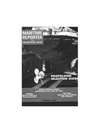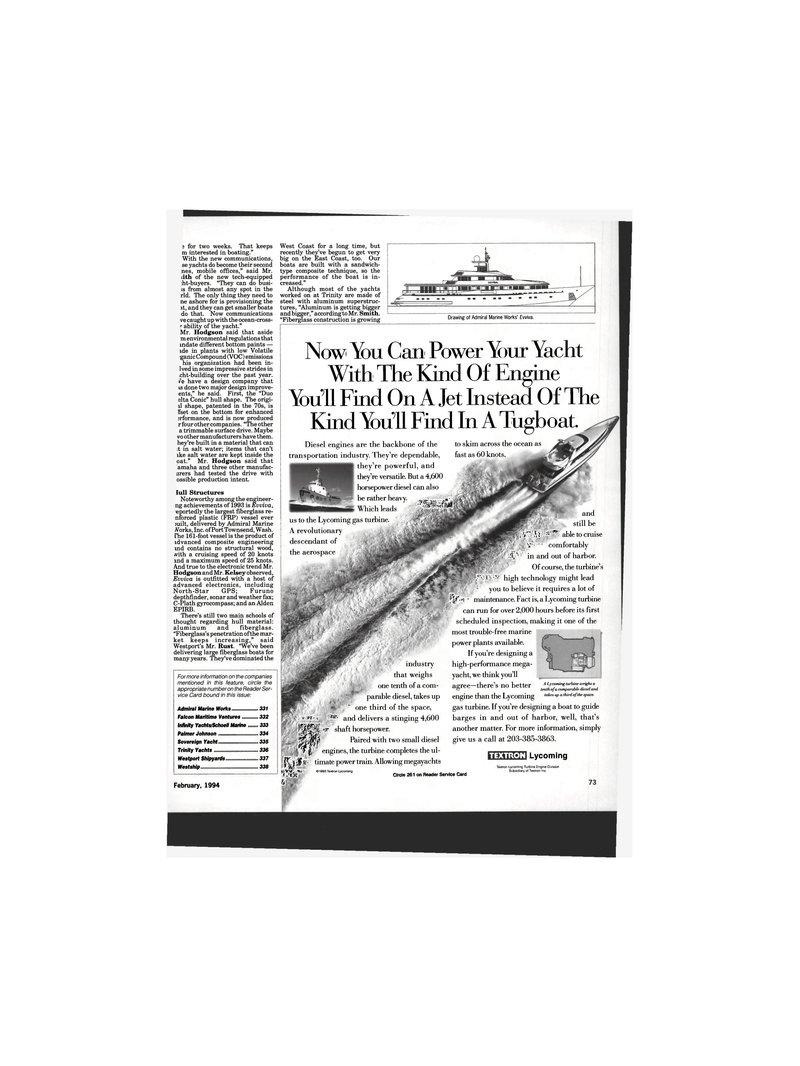
Page 63: of Maritime Reporter Magazine (February 1994)
Read this page in Pdf, Flash or Html5 edition of February 1994 Maritime Reporter Magazine
5 for two weeks. That keeps m interested in boating."
With the new communications, se yachts do become their second nes, mobile offices," said Mr. iith of the new tech-equipped :ht-buyers. "They can do busi- is from almost any spot in the rid. The only thing they need to ne ashore for is provisioning the it, and they can get smaller boats do that. Now communications ve caught up with the ocean-cross- * ability of the yacht."
Mr. Hodgson said that aside m environmental regulations that mdate different bottom paints — ide in plants with low Volatile ganic Compound (VOC) emissions his organization had been in- lved in some impressive strides in .cht-building over the past year. je have a design company that is done two major design improve- ents," he said. First, the "Duo elta Conic" hull shape. The origi- il shape, patented in the 70s, is fset on the bottom for enhanced jrformance, and is now produced r four other companies. "The other a trimmable surface drive. Maybe vo other manufacturers have them, hey're built in a material that can it in salt water; items that can't ike salt water are kept inside the oat." Mr. Hodgson said that amaha and three other manufac- urers had tested the drive with ossible production intent. lull Structures
Noteworthy among the engineer- ng achievements of 1993 is Evviva, •eportedly the largest fiberglass re- nforced plastic (FRP) vessel ever milt, delivered by Admiral Marine iVorks, Inc. ofPortTownsend, Wash.
The 161-foot vessel is the product of idvanced composite engineering ind contains no structural wood, with a cruising speed of 20 knots and a maximum speed of 25 knots.
And true to the electronic trend Mr.
Hodgson and Mr. Kelsey observed,
Evviva is outfitted with a host of advanced electronics, including
North-Star GPS; Furuno depthfinder, sonar and weather fax;
C-Plath gyrocompass; and an Alden
EPIRB.
There's still two main schools of thought regarding hull material: aluminum and fiberglass. "Fiberglass's penetration of the mar- ket keeps increasing," said
Westport's Mr. Rust. "We've been delivering large fiberglass boats for many years. They've dominated the
For more information on the companies mentioned in this feature, circle the appropriate number on the Reader Ser- vice Card bound in this issue:
Admiral Marine Works.—............. 331
Falcon Maritime Ventures .. 332
Infinity Yachts/Schoell Marine 333
Palmer Johnson 334
Sovereign Yacht 335
Trinity Yachts 336
Westport Shipyards... 337
Westship 338
West Coast for a long time, but recently they've begun to get very big on the East Coast, too. Our boats are built with a sandwich- type composite technique, so the performance of the boat is in- creased."
Although most of the yachts worked on at Trinity are made of steel with aluminum superstruc- tures, "Aluminum is getting bigger and bigger," according to Mr. Smith. "Fiberglass construction is growing Drawing of Admiral Marine Works' Evviva.
Now You Can Power Y>ur Yacht
With The Kind Of Engine
You'll Find On A Jet Instead Of The
Kind You'll Find In A Tugboat
Diesel engines are the backbone of the transportation industry. They're dependable, they're powerful, and they're versatile. But a 4,600 horsepower diesel can also be rather heavy. . .*.* 1 i \ ftr«Pyi
Which leads us to the Lycoming gas turbine.
A revolutionary descendant of to skim across the ocean as fast as 60 knots, the aerospace industry that weighs one tenth of a com- parable diesel, takes up " one third of the space, tsm arKj delivers a stinging 4,600 < shaft horsepower.
Paired with two small diesel
February, 1994 . V M, i J 11| engines, the turbine completes the ul- ||jf v timate power train. Allowing megayachts \ .J'- ©1993 Textron Lycoming ' r ,'•"< kCircle 261 on Reader Service Card 6 and still be s V 'h'i',: ' * able to cruise
V' comfortably .i , " in and out of harbor.
Of course, the turbine's , high technology might lead ; you to believe it requires a lot of fy • maintenance. Fact is, a Lycoming turbine can run for over 2,000 hours before its first scheduled inspection, making it one of the most trouble-free marine power plants available.
If you're designing a high-performance mega- yacht, we think you'll agree—there's no better engine than the Lycoming gas turbine. If you're designing a boat to guide barges in and out of harbor, well, that's another matter. For more information, simply give us a call at 203-385-3863.
A Lycoming turbine weighs a tenth of a comparable diesel and takes up a third of the space.
TEXTRON Lycoming
Textron Lycoming Turbine Engine Division
Subsidiary of Textron Inc. 113

 62
62

 64
64
